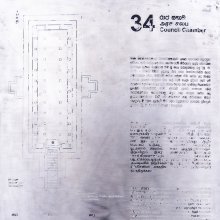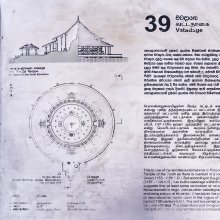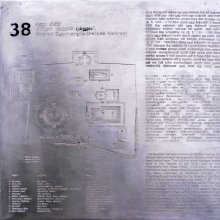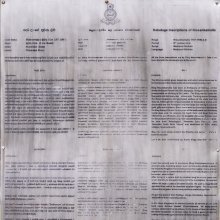Tam, Ṭāṃ, Tām: 14 definitions
Introduction:
Tam means something in Hinduism, Sanskrit, the history of ancient India, Marathi, Jainism, Prakrit, Hindi, Tamil. If you want to know the exact meaning, history, etymology or English translation of this term then check out the descriptions on this page. Add your comment or reference to a book if you want to contribute to this summary article.
Images (photo gallery)
In Hinduism
Vyakarana (Sanskrit grammar)
Source: Wikisource: A dictionary of Sanskrit grammarTam (तम्).—Personal ending तम् (tam) substituted for थम् (tham) in the impera. imperf. potential, benedictive, aorist and conditional; cf. P. III. 4.85, 101
--- OR ---
Tām (ताम्).—Personal ending substituted for तस् (tas) of the 3rd pers. dual in the imperative, imperfect, potential, benedictive, aorist and conditional; cf. P. III.4.85, 101.

Vyakarana (व्याकरण, vyākaraṇa) refers to Sanskrit grammar and represents one of the six additional sciences (vedanga) to be studied along with the Vedas. Vyakarana concerns itself with the rules of Sanskrit grammar and linguistic analysis in order to establish the correct context of words and sentences.
India history and geography
Source: Cologne Digital Sanskrit Dictionaries: Indian Epigraphical GlossaryṬaṃ.—(Chamba, etc.), abbreviation of ṭaṃkā. Note: ṭaṃ is defined in the “Indian epigraphical glossary” as it can be found on ancient inscriptions commonly written in Sanskrit, Prakrit or Dravidian languages.
--- OR ---
Ṭaṃ.—abbreviation of ṭaṅka. Note: ṭaṃ is defined in the “Indian epigraphical glossary” as it can be found on ancient inscriptions commonly written in Sanskrit, Prakrit or Dravidian languages.

The history of India traces the identification of countries, villages, towns and other regions of India, as well as mythology, zoology, royal dynasties, rulers, tribes, local festivities and traditions and regional languages. Ancient India enjoyed religious freedom and encourages the path of Dharma, a concept common to Buddhism, Hinduism, and Jainism.
Languages of India and abroad
Marathi-English dictionary
Source: DDSA: The Aryabhusan school dictionary, Marathi-Englishṭāṃ (टां).—or-
--- OR ---
ṭāṃ (टां).—or-
--- OR ---
ṭāṃ (टां).—or-
Marathi is an Indo-European language having over 70 million native speakers people in (predominantly) Maharashtra India. Marathi, like many other Indo-Aryan languages, evolved from early forms of Prakrit, which itself is a subset of Sanskrit, one of the most ancient languages of the world.
Sanskrit dictionary
Source: Cologne Digital Sanskrit Dictionaries: Shabda-Sagara Sanskrit-English DictionaryTam (तम्).—[(ira u) irtamu] r. 4th cl. (tāmyati) 1. To desire. 2. To be distressed in body or mind. E. khede aka0 icchāyāṃ saka-divā-pa0 seṭ .
Source: Cologne Digital Sanskrit Dictionaries: Benfey Sanskrit-English DictionaryTam (तम्).—i. 4, tāmya, [Parasmaipada.] (also [Ātmanepada.], [Rāmāyaṇa] 2, 63, 50), 1. To become breathless, [Suśruta] 1, 120, 16. 2. To breathe with difficulty, [Rājataraṅgiṇī] 5, 344. 3. To become exhausted, [Rāmāyaṇa] 2, 52, 25. 4. To be distressed, [Amaruśataka, (ed. Calcutt.)] 7. 5. To become staring, immoveable, [Amaruśataka, (ed. Calcutt.)] 3. 6. To choke (ved.). 7. † To desire. Ptcple. of the pf. pass. tānta, Distressed, [Kathāsaritsāgara, (ed. Brockhaus.)] 24, 65. [Causal.] tamaya.
— With the prep. ā ā, To become breathless, [Rāmāyaṇa] 2, 63, 50.
— With ud ud, 1. To become breathless, [Rāmāyaṇa] 2, 65, 45 Gorr. 2. To be distressed, [Rājataraṅgiṇī] 6, 124.
— With ni ni in nitānta, Excessive, much, [Pañcatantra] i. [distich] 139. ºta + m, adv. Much, excessively, [Rājataraṅgiṇī] 4, 634; violently, [Bhāgavata-Purāṇa, (ed. Burnouf.)] 4, 8, 15.
— With pari pari, To gasp. [Suśruta] 2, 447, 7.
— pra pra, 1. To become breathless, [Suśruta] 1, 121, 1. 2. To become exhausted, Mahābhārata 12, 12241. 3. To be beside one’s self, [Rāmāyaṇa] 2, 12, 105.
— With sam sam, To become exhausted, [Gītagovinda. ed. Lassen.] 4, 21.
— Cf. probably [Latin] temere, con-tumax, temetum, abs-temius perhaps [Old High German.] damf, damfjan, an old Causal (to choke).
Source: Cologne Digital Sanskrit Dictionaries: Cappeller Sanskrit-English DictionaryTam (तम्).—tāmyati (tāmyate), [participle] tānta become dark, dull, or stiff; faint away, be exhausted, lauguish, perish (also [impersonally] [with] [accusative] of subj.).
Source: Cologne Digital Sanskrit Dictionaries: Monier-Williams Sanskrit-English DictionaryTam (तम्):—[class] 4. tāmyati ([Pāṇini 7-3, 74]; rarely [Ātmanepada] [Rāmāyaṇa ii, 63, 46; Gīta-govinda v, 16]; [perfect tense] tatāma, [Śatapatha-brāhmaṇa iv]; [Aorist] [Passive voice] atami, [Pāṇini 7-3, 34; Kāśikā-vṛtti]; [Vedic or Veda] [infinitive mood] tamitos, with ā preceding, ‘till exhaustion’ [Taittirīya-brāhmaṇa i, 4, 4, 2; Tāṇḍya-brāhmaṇa xii; Lāṭyāyana; Āpastamba-dharma-sūtra]; [perfect tense] [Passive voice] p. -tānta q.v.)
—to gasp for breath (as one suffocating), choke, be suffocated, faint away, be exhausted, perish, be distressed or disturbed or perplexed, [Ṛg-veda ii, 30, 7] (na mā tamat [aor. subj.] ‘may I not be exhausted’), [Kāṭhaka; Taittirīya-brāhmaṇa] etc.;
—to stop (as breath), become immovable or stiff, [Suśruta; Mālatīmādhava; Amaru-śataka; Rājataraṅgiṇī v, 344];
—to desire (cf. 2. ma, mata), [Dhātupāṭha xxvi, 93] :—[Causal] tamayati ([Aorist] [Passive voice] atāmi, [Pāṇini 6-4, 93; Kāśikā-vṛtti]) to suffocate, deprive of breath, [Śatapatha-brāhmaṇa iii, 3, 2, 19 and 8, 1, 15; Kātyāyana-śrauta-sūtra vi, 5, 18];—cf. a-tameru.
Source: Cologne Digital Sanskrit Dictionaries: Yates Sanskrit-English DictionaryTam (तम्):—(ya, u, ir) tāmyati 4. a. To desire; to be pained in body or mind.
Source: DDSA: Paia-sadda-mahannavo; a comprehensive Prakrit Hindi dictionary (S)Tam (तम्) in the Sanskrit language is related to the Prakrit words: Tama, Tamma.
[Sanskrit to German]
Sanskrit, also spelled संस्कृतम् (saṃskṛtam), is an ancient language of India commonly seen as the grandmother of the Indo-European language family (even English!). Closely allied with Prakrit and Pali, Sanskrit is more exhaustive in both grammar and terms and has the most extensive collection of literature in the world, greatly surpassing its sister-languages Greek and Latin.
Hindi dictionary
Source: DDSA: A practical Hindi-English dictionaryTam in Hindi refers in English to:—(nm) darkness; gloom; (fig.) ignorance..—tam (तम) is alternatively transliterated as Tama.
...
Prakrit-English dictionary
Source: DDSA: Paia-sadda-mahannavo; a comprehensive Prakrit Hindi dictionaryTaṃ (तं) in the Prakrit language is related to the Sanskrit word: Tat.
Prakrit is an ancient language closely associated with both Pali and Sanskrit. Jain literature is often composed in this language or sub-dialects, such as the Agamas and their commentaries which are written in Ardhamagadhi and Maharashtri Prakrit. The earliest extant texts can be dated to as early as the 4th century BCE although core portions might be older.
Kannada-English dictionary
Source: Alar: Kannada-English corpusTām (ತಾಮ್):—[pronoun] plural form of the pronoun 'ತಾನ್ [tan] (corresponding to 'they' in English) used in reflexive or reciprocal sense.
Kannada is a Dravidian language (as opposed to the Indo-European language family) mainly spoken in the southwestern region of India.
See also (Relevant definitions)
Starts with (+1439): Bodhidharma, Tam bra, Tam Jivam Tam Sariram Sutta, Tam lang, Tam loeng, Tam mu sa, Tam nai, Tam naji, Tam that, Tam ye meao, Tam ye tuapa, Tam-barki, Tam-fa-tu, Tam-hidi, Tam-seetapandu, Tam-tomenal, Tam-yae, Tam-yae-chang, Tam-yae-khrua, Tam-yae-tua-mae.
Ends with (+4298): A-car-kariyavatam, A-dhyatam, A-patamattam, A-piracittacampantam, A-vitam, Abhidutam, Abhimarutam, Abhininartam, Abhinivartam, Abhishankitam, Abhivatam, Abhivyaktam, Abhyastam, Abhyavartam, Acakantam, Acamantam, Acamarutam, Acamatam, Acamimarattam, Acammatam.
Full-text (+4463): Tams, Abhilashita, Avanata, Gatagata, Pratam, Jhatajhata, Anihita, Tamkrita, Nitanta, Purata, Khallita, Ghataghata, Apavarita, Bhakshita, Vilambita, Parkata, Avatamsa, Vyudhakankata, Pragrata, Anudita.
Relevant text
Search found 200 books and stories containing Tam, Ṭāṃ, Tām, Ṭaṃ, Taṃ; (plurals include: Tams, Ṭāṃs, Tāms, Ṭaṃs, Taṃs). You can also click to the full overview containing English textual excerpts. Below are direct links for the most relevant articles:
Brihad Bhagavatamrita (commentary) (by Śrī Śrīmad Bhaktivedānta Nārāyana Gosvāmī Mahārāja)
Verse 2.3.115 < [Chapter 3 - Bhajana (loving service)]
Verse 2.1.141 < [Chapter 1 - Vairāgya (renunciation)]
Verse 2.1.87 < [Chapter 1 - Vairāgya (renunciation)]
Garga Samhita (English) (by Danavir Goswami)
Verses 5.24.15-16 < [Chapter 24 - The Killing of the Kola Demon]
Verse 2.21.39 < [Chapter 21 - The Rāsa-dance Pastime]
Verse 5.7.23 < [Chapter 7 - The Killing of Kuvalayāpīḍa]
The Agni Purana (by N. Gangadharan)
Chapter 201 - Mode of worshipping Viṣṇu in a figure of nine compartments
Chapter 316 - Narration of different kinds of mantras
Chapter 314 - Mantras relating to the worship of Goddess Tvaritā
Rig Veda (translation and commentary) (by H. H. Wilson)
Bhakti-rasamrta-sindhu (by Śrīla Rūpa Gosvāmī)
Verse 3.3.55 < [Part 3 - Fraternal Devotion (sakhya-rasa)]
Verse 4.9.6 < [Part 9 - Incomplete Expression of Mellows (rasābhāsa)]
Verse 2.4.142 < [Part 4 - Transient Ecstatic Disturbances (vyābhicāri-bhāva)]
Hari-bhakti-kalpa-latikā (by Sarasvati Thkura)
Related products





